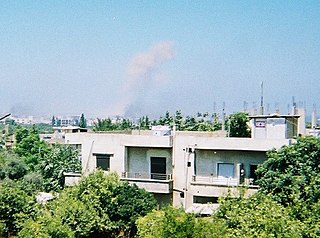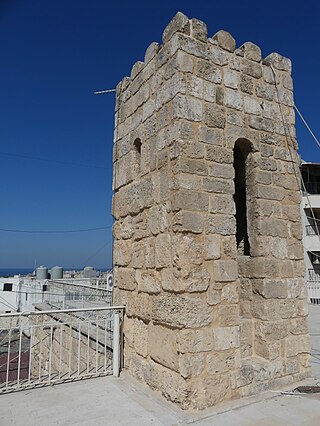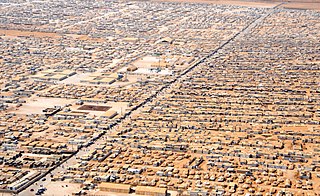
This is a demography of the population of Lebanon including population density, education level, health of the populace, economic status, religious affiliations and other aspects of the population.
Palestinian refugees are citizens of Mandatory Palestine, and their descendants, who fled or were expelled from their country over the course of the 1947–1949 Palestine war and the Six-Day War. Most Palestinian refugees live in or near 68 Palestinian refugee camps across Jordan, Lebanon, Syria, the West Bank and the Gaza Strip. In 2019 more than 5.6 million Palestinian refugees were registered with the United Nations.
Camps are set up by the United Nations Relief and Works Agency (UNRWA) in Jordan, Lebanon, Syria, the West Bank and the Gaza Strip to accommodate Palestinian refugees registered with UNRWA, who fled or were expelled during the 1948 Palestinian expulsion and flight after the 1948 Arab–Israeli War or in the aftermath of the Six-Day War in 1967, and their patrilineal descendants. There are 68 Palestinian refugee camps, 58 official and 10 unofficial, ten of which were established after the Six-Day War while the others were established in 1948 to 1950s.
Jund al-Sham is or was the name of multiple Sunni Islamic jihadist militant groups.
Ain al-Hilweh, also spelled as Ayn al-Hilweh and Ein al-Hilweh, is the largest Palestinian refugee camp in Lebanon. It had a population of over 70,000 Palestinian refugees but swelled to nearly 120,000, as a result of influx of refugees from Syria since 2011. The camp is located west of the village Miye ou Miye and the Mieh Mieh refugee camp, southeast of the port city of Sidon and north of Darb Es Sim.
Human Rights in Lebanon refers to the state of human rights in Lebanon, which were considered to be on par with global standards in 2004. Some believed to be criminals and terrorists are said to be detained without charge for both short and long periods of time. Freedom of speech and of the press are ensured to the citizens by the Lebanese laws which protect the freedom of each citizen. Palestinians living in Lebanon are heavily deprived of basic civil rights. They cannot own homes or land, and are barred from becoming lawyers, engineers and doctors. However, the Lebanese government has reduced the number of restricted jobs and created a national dialogue committee for the issue. During the Arab Spring, Lebanon experienced major protests and sectarian violence, but avoided the large-scale political upheaval seen in many parts of the Arab world.

The Shatila refugee camp, also known as the Chatila refugee camp, is a settlement originally set up for Palestinian refugees in 1949. It is located in southern Beirut, Lebanon and houses more than 9,842 registered Palestine refugees. Since the eruption of the Syrian Civil War, the refugee camp has received a large number of Syrian refugees. In 2014, the camp's population was estimated to be between 10,000 and 22,000.

The 2007 Lebanon conflict began when fighting broke out between Fatah al-Islam, an Islamist militant organization, and the Lebanese Armed Forces (LAF) on May 20, 2007 in Nahr al-Bared, a UNRWA Palestinian refugee camp near Tripoli.

Yarmouk is a 2.11-square-kilometer (520-acre) district of the city of Damascus, populated by Palestinians. It is located 8 kilometers (5.0 mi) from the center of Damascus and within municipal boundaries; this was not the case when it was established in 1957. It contains hospitals and schools. Yarmouk is an "unofficial" refugee camp, as UNRWA rejected a Syrian government request to recognize the camp in 1960. Now depopulated, it was previously home to the largest Palestinian refugee community in Syria. As of June 2002, there had been 112,550 registered refugees living in Yarmouk.
Palestinian people have a history that is often linked to the history of the Arab Nation. Upon the advent of Islam, Christianity was the major religion of Byzantine Palestine. Soon after the rise of Islam, Palestine was conquered and brought into the rapidly expanding Islamic empire. The Umayyad empire was the first of three successive dynasties to dominate the Arab-Islamic world and rule Palestine, followed by the Abbasids and the Fatimids. Muslim rule was briefly challenged and interrupted in parts of Palestine during the Crusades, but was restored under the Mamluks.

Palestinians in Iraq are people of Palestinians, most of whom have been residing in Iraq after they were displaced in 1948. Before 2003, there were approximately 34,000 Palestinians thought to be living in Iraq, mainly concentrated in Baghdad. However, since the 2003 Iraq War, the figure lies between 10,000–13,000, although a precise figure has been hard to determine. The situation of Palestinians in Iraq deteriorated after the fall of Saddam Hussein and particularly following the bombing of the Al-Askari Mosque in 2006. Since then, with the rise in insecurity throughout Iraq, they have been the target of expulsion, persecution and violence by Shia militants, and the new Iraqi Government with militant groups targeting them for preferential treatment they received under the Ba'ath Party rule. Currently, several hundred Palestinians from Iraq are living in border camps, after being refused entry to neighbouring Jordan and Syria. Others have been resettled to third countries.
Mieh Mieh refugee camp is a Palestinian refugee camp in Lebanon, located on the outskirts of Mieh Mieh village in the hills 4 kilometers (2.5 mi) east of the southern city of Sidon. The original refugees in the camp generally came from Saffourieh, Tiereh, Haifa and Miron, in what is now Israel. It was established in 1954 on land leased from private landowners of the Miye ou Miye village. Around the 1990s, the Mieh Mieh camp was located on 60 dunams in Miye ou Miye village. Today, the camp is 1.8 times that size at 108 dunams. In 2003, it had a population of 5,037.

Burj el-Shemali is a municipality located some 86 km south of Beirut and 3 km east of the Tyre/Sour peninsula, merging into its urban area. It is part of the Tyre Union of Municipalities within the Tyre District of the South Governorate of Lebanon.

Lebanese nationality law governs the acquisition, transmission and loss of Lebanese citizenship. Lebanese citizenship is the status of being a citizen of Lebanon and it can be obtained by birth or naturalization. Lebanese nationality is transmitted paternally. Therefore, a Lebanese man who holds Lebanese citizenship can automatically confer citizenship to his children and foreign wife. Under the current law, descendants of Lebanese emigrants can only receive citizenship from their father and women cannot pass on citizenship to their children or foreign spouses.

Syrian refugee camp and shelters are temporary settlements built to receive internally displaced people and refugees of the Syrian Civil War. Of the estimated 7 million persons displaced within Syria, only a small minority live in camps or collective shelters. Similarly, of the 8 million refugees, only about 10 percent live in refugee camps, with the vast majority living in both urban and rural areas of neighboring countries. Beside Syrians, they include Iraqis, Palestinians, Kurds, Yazidis, individuals from Somalia, and a minority of those who fled the Yemeni and Sudanese civil wars.

Present absentees are Arab internally displaced persons (IDPs) who fled or were expelled from their homes in Mandatory Palestine during the 1947–1949 Palestine war but remained within the area that became the state of Israel.

Palestinians in Syria are people of Palestinian origin, most of whom have been residing in Syria after they were displaced from their homeland during the 1948 Palestinian expulsion and flight. Palestinians hold most of the same rights as the Syrian population, but cannot become Syrian nationals except in rare cases. In 2011, there were 526,744 registered Palestinian refugees in Syria. Due to the Syrian Civil War, the number of registered refugees has since dropped to about 450,000 due to many Palestinians fleeing to Lebanon, Jordan or elsewhere in the region to escaping to Europe as refugees, especially to Germany and Sweden.
Syrians in Lebanon refers to the Syrian migrant workers and, more recently, to the Syrian refugees who fled to Lebanon during the Syrian Civil War. The relationship between Lebanon and Syria includes Maronite-requested aid during Lebanon's Civil War which led to a 29-year occupation of Lebanon by Syria ending in 2005. Following the outbreak of the Syrian Civil War, refugees began entering Lebanon in 2011. Lebanon's response towards the influx of refugees has been criticized as negative, with the Lebanese government leaving them undocumented and limited and attacks on Syrian refugees by Lebanese citizens which go unaddressed by authorities. Despite the strained relationship between the Syrians and Lebanese, taking into consideration only Syrian refugees, Lebanon has the highest number of refugees per capita in the world, with one refugee per four nationals. The power dynamic and position of Syria and Lebanon changed drastically in such a short amount of time, it is inevitable that sentiments and prejudices prevailed despite progressions and changes in circumstance.
The following lists events in the year 2017 in Lebanon.
On 30 July 2023, fighting broke out inside the Ain al-Hilweh Palestinian refugee camp in Lebanon after Islamist gunmen tried to assassinate Fatah militant Mahmoud Khalil, killing a companion of his instead.













